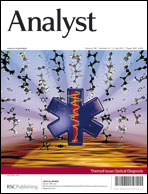A new dimension for cell identification by FTIR spectroscopy: depth profiling in attenuated total reflection
Abstract
The multiresistant phenotype is an important problem in cancer chemotherapy. It is characterized by cell resistance to multiple and structurally unrelated

- This article is part of the themed collection: Optical Diagnosis

 Please wait while we load your content...
Please wait while we load your content...